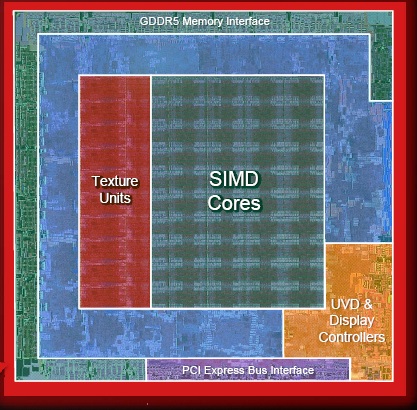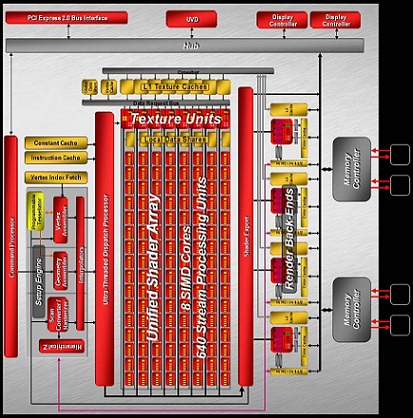|
Before we dive into the benchmarks we need to take a look at how the new 4890 stacks up against the existing lineup of 4XXX cards. Is the 4890 nothing more than a refresh of an old card with increased clocks or is there more beef under the hood?
Specifications:
The New 4770 in the middle.
| ATI Radeon 4670 | ATI Radeon 4770 | ATI Radeon 4850 | |
| Process | 55nm |
40nm |
55nm |
| Transistors | 514 M |
826M |
956M |
| Engine Clock | 750 MHz |
750 MHz |
625 MHz |
| Stream Processors | 320 |
640 |
800 |
| Compute Performance | 480 GFLOPs |
960 GFLOPs |
1.0 TFLOPs |
| Texture Units | 32 |
32 |
40 |
| Texture Fillrate | 24.0 GTextels/s |
24.0 GTextels/s |
25.0 GTextels/s |
| ROPs | 8 |
16 |
16 |
| Pixel Fillrate | 6.0 GPixels/s |
12.0 GPixels/s |
10.0 GPixels/s |
| Z/Stencil | 32 |
64 |
64 |
| Z Fillrate | 24.0 GSamples/s |
48.0 GSamples/s |
40.0 GSamples/s |
| Memory Type | GDDR3 |
GDDR5 |
GDDR3 |
| Memory Clock | 1000 MHz |
800 MHz |
1000 MHz |
| Frame Buffer Size | 512MB/1GB |
512 MB |
512MB/1GB |
| Memory Data Rate | 2.0 Gbps |
3.2 Gbps |
2.0 Gbps |
| Memory Bus | 128-bit |
128-bit |
256-bit |
| Memory Bandwidth | 32.0 GB/s |
51.2 GB/s |
64.0 GB/s |
| Maximum Board Power | 59 W |
80 W |
110 W |
ATI places the 4770 to be the next budget card you must have. A quick look at its specifications shows us why. Respectable performance stats at a modest price and low overall power usage. The 4770 is also ATI's first venture into 40nm territory which is why its heat output is so low given its otherwise lofty specifications.
The new 4890 to the right.
| ATI Radeon 4850 | ATI Radeon 4870 | ATI Radeon 4890 | |
| Process | 55nm |
55nm |
55nm |
| Transistors | 956M |
956M |
956M |
| Engine Clock | 625 MHz |
750 MHz |
850 MHz |
| Stream Processors | 800 |
800 |
800 |
| Compute Performance | 1.0 TFLOPs |
1.2 TFLOPs |
1.36 TFLOPs |
| Texture Units | 40 |
40 |
40 |
| Texture Fillrate | 25.0 GTextels/s |
30.0 GTextels/s |
34.0 GTextels/s |
| ROPs | 16 |
16 |
16 |
| Pixel Fillrate | 10.0 GPixels/s |
12.0 GPixels/s |
13.6 GPixels/s |
| Z/Stencil | 64 |
64 |
64 |
| Z Fillrate | 40.0 GSamples/s |
48.0 GSamples/s |
54.4 GSamples/s |
| Memory Type | GDDR3 |
GDDR5 |
GDDR5 |
| Memory Clock | 1000 MHz |
900 MHz |
975 MHz |
| Frame Buffer Size | 512MB/1GB |
512MB/1GB |
1GB |
| Memory Data Rate | 2.0 Gbps |
3.6 Gbps |
3.9 Gbps |
| Memory Bus | 256-bit |
256-bit |
256-bit |
| Memory Bandwidth | 64.0 GB/s |
115.2 GB/s |
124.8 GB/s |
| Maximum Board Power | 110 W |
160 W |
190 W |
| Idle Board Power | 30 W |
90 W |
60 W |
From the surface the new 4890 looks like nothing more than an overclocked 4870 and for the most part you would be correct. Peeking beneath the surface we see that ATI has done some fine tuning to the engine that drives the 4890 which is evident by simply looking at the difference between idle board power on the 4870 and 4890. Even though the 4890 runs faster and otherwise has the same specifications, at idle it runs cooler, a whopping 30 Watts cooler!
So Where's The Beef?
Popping the hood we see that AMD has taken some very specific steps to work on the efficiency of the GPU. The new 4890 is shown below:
 |
The red ring you see surrounding the GPU are decaps and is new to the 4890. As you can expect this leads to a minor increase in the GPU die area or surface area leading to lower temps. Overall changes include:
|
Changes to the 4770 of course include a much smaller die based on the 40nm as opposed to the 55nm GPU and is shown below:
 |
As you can see the differences start at a very basic level and include the following:
|
Overall we would expect the new 4770 to overclock very well but are unable to report on that aspect of the new 4770 as we do not have a sample of that card in for testing at this time. The new 40nm process and higher GDDR5 memory should post some nice results of course dependant on the speed of the actual memory used on the board.
OUR OTHER RELEVANT REVIEWS




